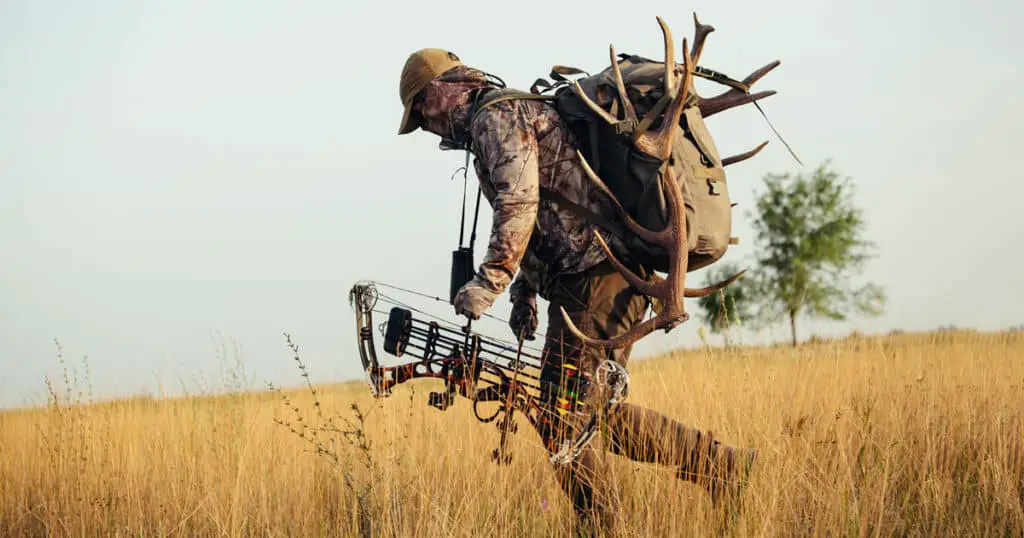Tracking deer is essential for hunting, but you might be interested in tracking deer for other reasons. Enthusiasts, photographers, and ordinary nature lovers enjoy seeing deer in the wild. If you’re serious about seeing deer, you need to understand how deer move in their habitat and the signs they leave behind. Keep reading to find out how to track deer.
It takes years to master deer tracking, but you can learn the fundamentals quickly. The best way to learn how to track deer is to get out there and start trying. And make sure to use the deer tracking tips we’ll go over here.
But first, let’s start with the fundamentals you need to know before you head out tracking.
Deer Signs: Tracks
A deer’s tracks are one of the most obvious signs of deer presence. It’s pretty easy to recognize animal tracks, but it can be harder to identify what kind of animal made them.
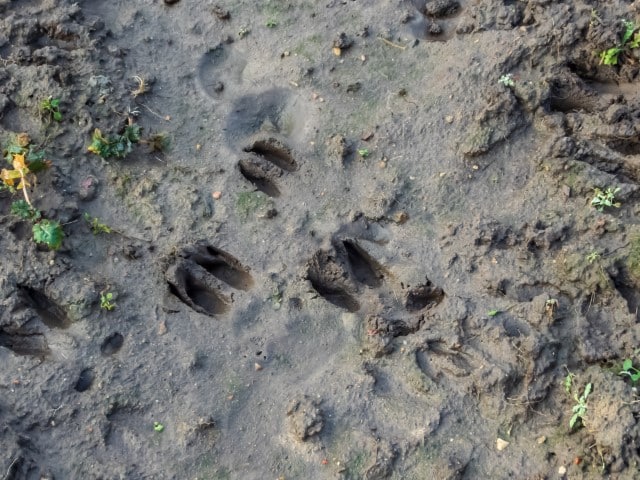
If you’re an inexperienced tracker, you may confuse deer tracks with tracks of other animals, and you may have trouble differentiating between the prints of different deer species.
Once you know what to look for, you shouldn’t have any trouble confusing deer tracks with those of other animals. You can recognize deer tracks by their hoof shape and size.
Some mammals like horses have similar hooves, but horse tracks are much larger than deer hooves and have a different shape.
Some larger species, like Moose, will have impressions from their dewclaws trailing the main hoofprint, whereas White Tailed Deer will not.
About the Size of Deer Hoof Prints
Deer hooves are smaller than you would think. Also, they’re characterized by the two long, almost oval-shaped hooves and the space between them.
A deer’s feet are directly underneath its shoulders and torso. That’s why they make a deer look a bit smaller than it really is with the addition of its neck and tail.
There will usually be four track marks and you can use these to easily trace the path a deer has taken. However, tracks are easily damaged.
Rainfall, wind, and other animals can ruin track markings. Human presence may also interfere with tracks.
Tracks are most visible in the mud and snow of a deer’s habitat. If there are lots of leaves, it might be harder to recognize the tracks.
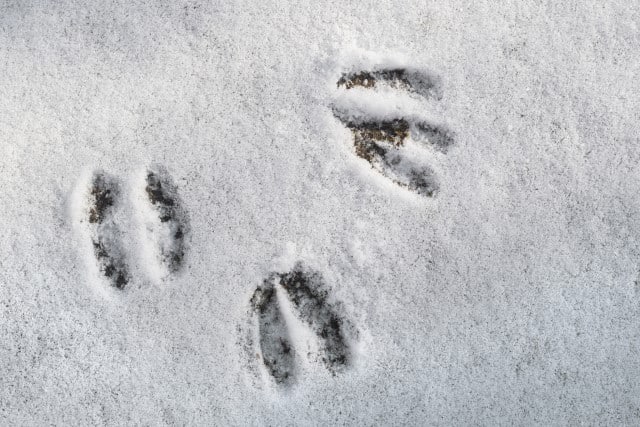
Track depth may vary.
Once you become more experienced in tracking, you should be able to distinguish between tracks when a deer has been running as opposed to walking, and you may be able to gain insight to the size of the deer.
Keep in mind that since deer like to jump, their tracks won’t necessarily have walking distance between them. Deer can jump several feet, meaning you might have to search for the tracks.
Deer Signs: Deer Scat
Scat is the other easiest way to detect and track a deer. You might think that all animal droppings look alike, but that’s not the case.
We can identify deer droppings by their small, round pellet shape and tendency to cluster. The individual pellets will often be clustered in one spot like a bunch of grapes as opposed to scattered around.
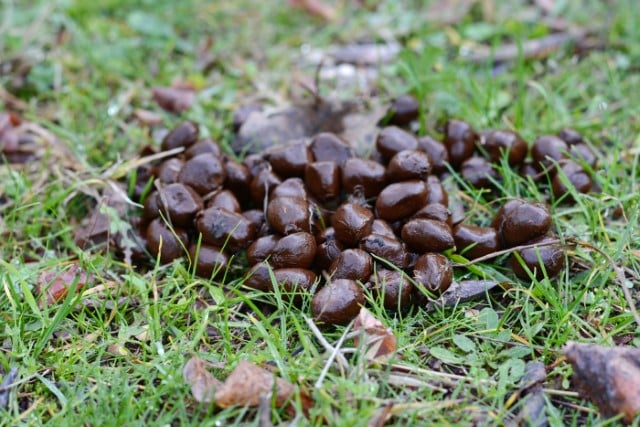
They look similar to rabbit droppings but are larger.
Smaller deer and baby deer (called fawns) will have smaller droppings, so they could potentially be confused with the droppings of raccoons or tinier critters.
The consistency and freshness of the droppings provide information as to when and where the deer was present.
Fresh droppings will be moister and smell worse than older droppings. Deer droppings tend to dry out after a few hours.
Fresh droppings probably mean the deer was in the spot within the past few hours.
But remember, deer can cover a lot of ground in a short period of time. The animal may not necessarily still be in the area.
Other Common Deer Signs
Tracks and scat are the most recognizable signs of deer, and almost everyone has probably seen these when walking in the woods.
You’ll also start to notice other signs of deer presence once you’ve spent more time searching for deer.
You can usually tell if deer have been in an area based on how their food sources look. Deer eat a wide range of vegetation types.
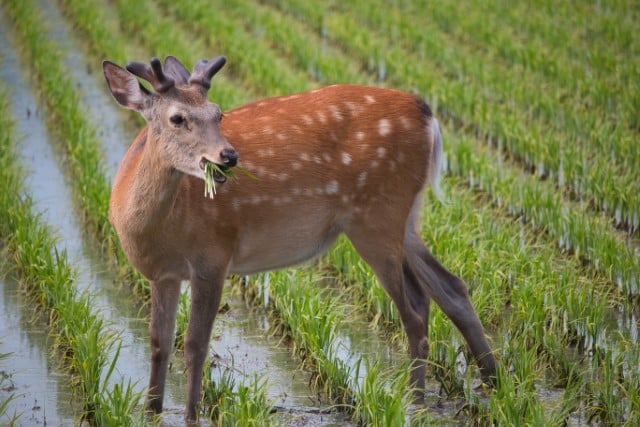
A deer won’t necessarily eat an entire plant all at once.
If you notice a shrub with some leaves torn off or a branch bitten off, this could be a sign of deer. Picked-over berries are another sign of deer presence.
Look for bite marks on tall grass or shrubs with large leaves.
A deer won’t usually pull up the entire blade of grass or shrub. Instead, it will nibble off the top parts.
These bite marks will show teeth that are closely squished together. You should see signs that the teeth are fairly flat. We have a comprehensive article about deer teeth that may help you.
Since deer are herbivores, they don’t have incisors like humans or meat-eating animals. Because of this, their bite is easily recognizable.
Searching for Deer Bedding
A deer bed is another obvious sign of deer. Deer bedding areas aren’t as obvious as human beds, but once you’ve found a few, you’ll be able to recognize them quickly.
Once deer find a nice spot to sleep, they will usually return to it several times.
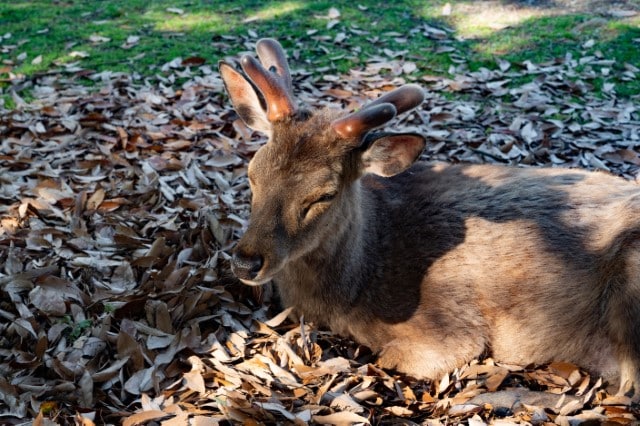
Deer don’t sleep through the night. Instead, they take small naps throughout the day.
Deer often have to wake up and flee from predators at a second’s notice, meaning they need a bed that has a good escape route.
Deer may sleep in meadows, but they will usually stay close to the edge of a forest or on the slope of a hill.
A hill offers ideal protection from the wind. Predators like wolves have a very highly developed sense of smell, so the direction of the wind can have a huge impact on a deer’s survival.
Staying downwind also protects deer from the cold.
Topographical Maps
If you don’t have the opportunity to scout the area ahead of time, you can look at topographical maps to look for deer bedding areas. Topographical maps show the changes in elevation on a flat surface.
For example, a hill will be drawn with a large circle demonstrating the overall area of the hill and will have smaller circles inside of it to demonstrate depth.
Looking at these ahead of time can help give you an indication of where a deer bed might be located.
Deer beds will often be on the downwind side of a slope, but they also favor areas slightly above a valley or a meadow surrounded by hills.
Deer are better climbers than some of their main predators, so a hill offers them an ideal escape route.
Ideally, you’ll want to scout out the area ahead of time. Keep in mind that a deer’s bedding habits vary depending on the season.
If it detects a human presence near its bed, it’s probably going to find another place to sleep.
Staying Out of Sight
This is perhaps the most important thing you can do when tracking deer. Deer have extremely sharp instincts and senses.
Cervids can also see much farther than humans, and they have more developed night vision.
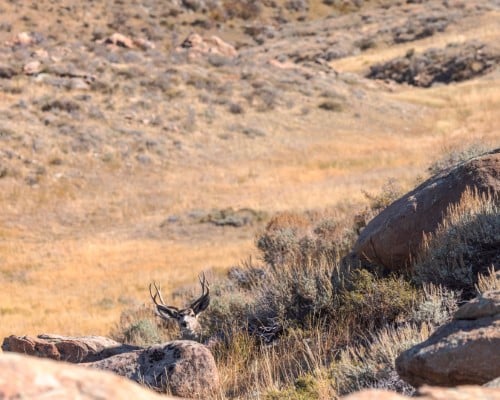
In addition to being able to see farther and better at night, deer also have a wider field of vision.
Human eyes are positioned to look only straight ahead, meaning that humans only have a 180-degree field of vision.
A deer’s eyes are positioned closer to the side of its head, so they have a more powerful peripheral vision.
Vision is not a deer’s only enhanced sense. Deer’s ears are better at picking up sounds at higher frequencies and from more directions than human ears.
So, even if a deer can’t see you because you’re wearing orange, there’s a high probability that it can hear you.
Most likely, a deer will smell you before it sees or hears you. Deer have very picky noses and can distinguish between hundreds of different smells.
Humans have a very unnatural scent compared to what they’re familiar with, so the smell of people stands out in the forest.
To make the deer more accustomed to their scents, most hunters will re-visit the same area throughout the year.
Some hunters will cover themselves with other scents such as deer urine to mask their human scent.
If you’re looking for deer for reasons other than hunting, you probably won’t want to go as far as dousing yourself with deer urine or using tarsal glands. But just not wearing strong perfumes or other scents will help.
Final Thoughts On How to Track Deer
Now you know how to track deer. But remember, practice makes perfect.
Don’t be discouraged if you don’t have any luck on your first try. Experience is one of the best teachers, and if you’d like to learn more, check out our in-depth guide to tracking deer.
There are many factors beyond your control. Maybe the weather is bad, or perhaps someone else was in the woods before you and scared off the deer.

